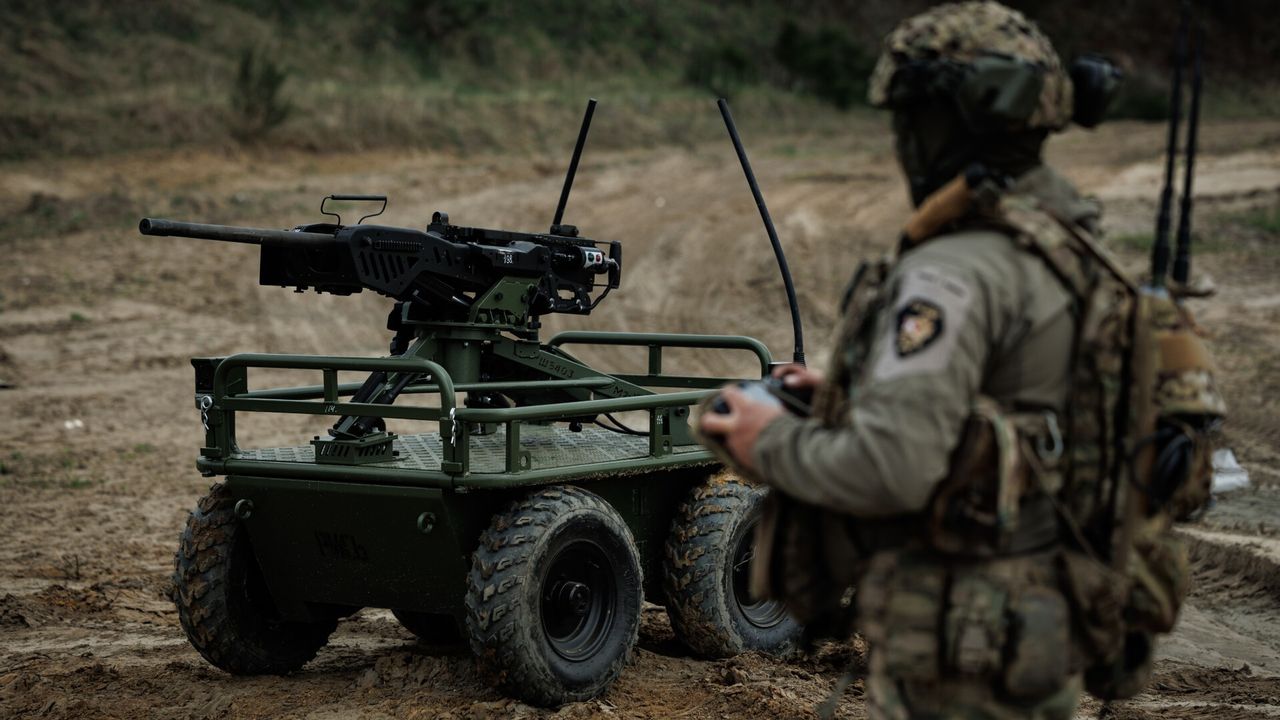Science
Ukraine’s Combat Robots Struggle with Starlink Bandwidth Limits

The bandwidth limitations of SpaceX’s Starlink internet are hindering Ukraine’s ability to deploy ground robots effectively in its ongoing conflict with Russia. As the war continues, these technological innovations are vital for logistics on the frontlines, but the current internet speed is proving inadequate for optimal operation.
Over the past year, Ukraine has sent thousands of wheeled ground robots to frontline military units. These unmanned ground vehicles (UGVs) assist in supplying troops, evacuating the wounded, and even conducting offensive operations against Russian forces. Unfortunately, the 10 megabits per second bandwidth available to each UGV limits the quality of video feeds essential for remote control. Vadym Burukin, CEO of the drone start-up Huless, explained, “If you want to drive fast, you need a frame rate of at least 30 frames per second to be able to control the robot.” With only ten frames per second available, the risk of accidents increases significantly.
Since the onset of the war, Starlink’s satellite network has become crucial for maintaining communication on the battlefield. Reports indicate that approximately 200,000 Starlink terminals are active in Ukraine, making it the largest user of Starlink services in Europe. However, the high number of devices concentrated in frontline areas slows the UGVs to a maximum speed of about 6 miles per hour (10 kilometers per hour). According to Andriy Dovbenko, CEO of the Ukrainian Tech Exchange network, this sluggish pace means these robots can take up to two hours to traverse the 12-mile-wide (20 kilometers) grey zone, a perilous area vulnerable to enemy drone attacks.
The terrain also presents challenges for Starlink terminals. The vibrations from navigating rugged landscapes can disrupt the connection, while environmental factors such as clouds and rain further degrade the signal. In response, Ukrainian tech innovators are exploring alternatives to enable ground robots to operate more effectively and swiftly.
To enhance communication capabilities, Burukin and his team have developed tethered drones that elevate signal repeaters to approximately 500 feet (150 meters). This setup extends the reach of radio signals from just a couple of kilometers to over 40 kilometers (25 miles). The airborne repeaters significantly increase operational range, allowing UGVs to conduct missions deeper into enemy territory without the risk of losing their Starlink connection.
“We recently managed to reach the Donbas arena, a major stadium in the center of Donetsk, using our repeating equipment,” Burukin stated. Donetsk has been under the control of Russian separatists since 2014 and is located about 30 miles (50 kilometers) from the current frontline.
Despite the challenges, Starlink remains a critical resource for Ukraine. Dovbenko noted, “There are many uses for Starlink in the war, but it’s not been developed specifically as a military technology, so it has its limitations. It would be good to have alternatives. But can we really produce an alternative to Starlink at scale? Probably not.”
Innovative solutions continue to emerge to address these challenges. AI-powered autonomous navigation systems are being integrated into military robots to mitigate disruptions caused by deliberate jamming and other signal issues. Ukrainian innovators anticipate that, within a few years, AI will enable these machines to operate independently, reducing the need for human oversight and making them more resistant to communication failures.
While fully autonomous warfare remains a distant goal, these advancements aim to minimize the risks faced by human soldiers on the frontlines. As Ukraine adapts to the realities of modern warfare, the interplay between technology and military strategy will remain crucial in shaping the battlefield landscape.
-

 Business1 week ago
Business1 week agoIconic Sand Dollar Social Club Listed for $3 Million in Folly Beach
-

 Politics2 weeks ago
Politics2 weeks agoAfghan Refugee Detained by ICE After Asylum Hearing in New York
-

 Health2 weeks ago
Health2 weeks agoPeptilogics Secures $78 Million to Combat Prosthetic Joint Infections
-

 Science1 week ago
Science1 week agoResearchers Achieve Fastest Genome Sequencing in Under Four Hours
-

 Lifestyle2 weeks ago
Lifestyle2 weeks agoJump for Good: San Clemente Pier Fundraiser Allows Legal Leaps
-

 Health1 week ago
Health1 week agoResearcher Uncovers Zika Virus Pathway to Placenta Using Nanotubes
-

 World2 weeks ago
World2 weeks agoUS Passport Ranks Drop Out of Top 10 for First Time Ever
-

 Entertainment2 weeks ago
Entertainment2 weeks agoJennifer Lopez Addresses A-Rod Split in Candid Interview
-

 Business2 weeks ago
Business2 weeks agoSan Jose High-Rise Faces Foreclosure Over $182.5 Million Loan
-

 World1 week ago
World1 week agoRegional Pilots’ Salaries Surge to Six Figures in 2025
-

 Science2 weeks ago
Science2 weeks agoMars Observed: Detailed Imaging Reveals Dust Avalanche Dynamics
-

 Top Stories1 week ago
Top Stories1 week agoChicago Symphony Orchestra Dazzles with Berlioz Under Mäkelä









